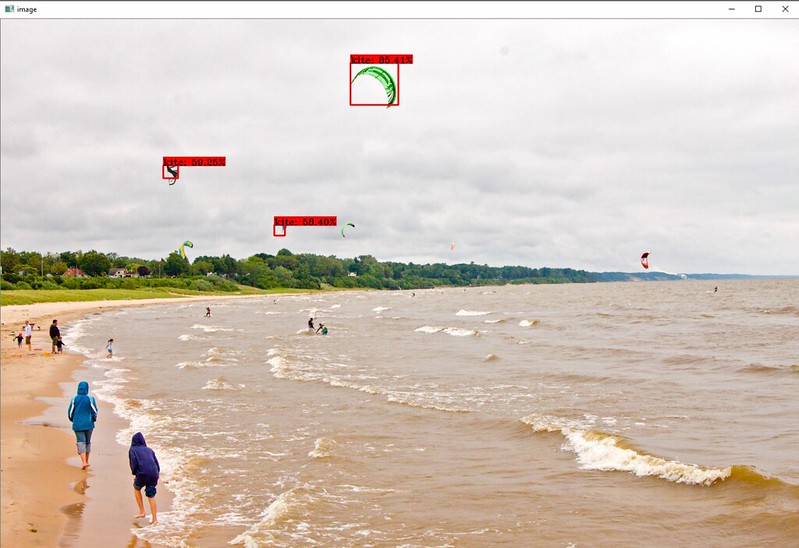
Object detection in machine learning is a popular topic, this time I will test Tensorflow Object Detection API in Python(official) and TensorflowSharp(wrapper) and check the result.
Let's start with Python, my code was modify from Object Detection Demo with some simplify, avoid path/protobuf issue, hope this simple example can help more people successful test it.
Here is some code explain, I will only list the part that I have modify.
Import
import numpy as np
import os
import tensorflow as tf
import cv2
import re
import time
if tf.__version__ != '1.4.0':
raise ImportError('Please upgrade your tensorflow installation to v1.4.0!')
Model
# What model to download.
MODEL_NAME = 'ssd_mobilenet_v1_coco_2017_11_17'
# Path to frozen detection graph. This is the actual model that is used for the object detection.
PATH_TO_CKPT = MODEL_NAME + '/frozen_inference_graph.pb'
# List of the strings that is used to add correct label for each box.
PATH_TO_LABELS = 'mscoco_label_map.pbtxt'
Loading label map
def load_label(file):
with open(file,'r') as fi:
match = re.finditer('item {\n name: \"(?P.*)\"\n id: (?P\d+)\n display_name: \"(?P Visualization result
# Visualization of the results of a detection.
for i in range(0,int(num[0])):
confidence = scores[0,i]
if confidence>0.5:
idx = int(classes[0,i])
box = boxes[0, i, 0:4] * np.array([h, w, h, w])
(y, x, y2, x2) = box.astype("int")
# draw rect
cv2.rectangle(image, (x, y), (x2, y2), colors[idx], 2)
# draw label
label = "{}: {:.2f}%".format([t['label'] for t in labels if t['id'] == str(idx)][0], confidence * 100)
print("{}".format(label))
(fontX, fontY) = cv2.getTextSize(label, cv2.FONT_HERSHEY_TRIPLEX, 0.5, 1)[0]
y = y + fontY if y-fontY<0 else y
cv2.rectangle(image,(x, y-fontY),(x+fontX, y),colors[idx],cv2.FILLED)
cv2.putText(image, label, (x, y), cv2.FONT_HERSHEY_TRIPLEX, 0.5, (0,0,0), 1)
cv2.imshow(image_path,image)
By default, this example using "ssd_mobilenet_v1_coco_2017_11_17" model, the result should be like that.


TensorflowSharp
Same as python, in C# I modify code from ExampleObjectDetection, dunno why in tensorflowSharp load image input to model are way complex than load in tensorflow-python, even I try to simplify it, the code still long and unfriendly, so I will not post code on here, but you still can check it on my github.Anyway, one thing to be noticed, the detect result in tensorflow-python and TensorflowSharp are different.

Using same model: "ssd_mobilenet_v1_coco_2017_11_17", in TensorflowSharp you can't get same result as official tensorflow, so if you want to develop in TensorflowSharp, be careful with it!!
Better result
You can try change model from Tensorflow detection model zoo to check the result, if using faster_rcnn_inception_resnet_v2_atrous_coco you can get better detection result like Tensorflow Object Detection API showed.
With the better detection result, the run time will increase a huge amount, on my pc the runtime will increase about 100 times(using CPU calculated).
Source Code
Here is my python's full code.import numpy as np
import os
import tensorflow as tf
import cv2
import re
import time
if tf.__version__ != '1.4.0':
raise ImportError('Please upgrade your tensorflow installation to v1.4.0!')
# What model to download.
#MODEL_NAME = 'faster_rcnn_inception_resnet_v2_atrous_coco_11_06_2017'
MODEL_NAME = 'ssd_mobilenet_v1_coco_2017_11_17'
# Path to frozen detection graph. This is the actual model that is used for the object detection.
PATH_TO_CKPT = MODEL_NAME + '/frozen_inference_graph.pb'
# List of the strings that is used to add correct label for each box.
PATH_TO_LABELS = 'mscoco_label_map.pbtxt'
detection_graph = tf.Graph()
with detection_graph.as_default():
od_graph_def = tf.GraphDef()
with tf.gfile.GFile(PATH_TO_CKPT, 'rb') as fid:
serialized_graph = fid.read()
od_graph_def.ParseFromString(serialized_graph)
tf.import_graph_def(od_graph_def, name='')
def load_image_into_numpy_array(image):
(im_width, im_height) = image.size
return np.array(image.getdata()).reshape(
(im_height, im_width, 3)).astype(np.uint8)
def load_label(file):
with open(file,'r') as fi:
match = re.finditer('item {\n name: \"(?P.*)\"\n id: (?P\d+)\n display_name: \"(?P All code will put on github.
BTW, here has another Tensorflow detection model zoo with more models, you can try it if need.

There's a bug with the tensorflowsharp code that gives you incorrect results. The fix is:
ReplyDeleteconst float scale = 1;
to
const float scale = 128;
I will try it, thank you.
DeleteWhat is now the best value for scale ?
DeleteWith 128 the result is getting worse (no kite recognized at all) than with 1 (3 kites detected with low percentage, as above).
Could you get the .NET sample working with TensorFlowSharp version 1.5.0 (works only with version 1.4.0) ?
ReplyDeleteThe following runtime exception is thrown in this case:
Error: untreated exception: System.DllNotFoundException: could not load DLL 'libtensorflow': the specified module could not be found.